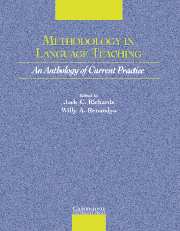Book contents
- Frontmatter
- Contents
- Acknowledgments
- Introduction
- Section I Approaches to Teaching
- Section 2 Lesson Planning and Classroom Management
- Section 3 Classroom Dynamics
- Section 4 Syllabus Design and Instructional Materials
- Section 5 Task and Project Work
- Section 6 Learning Strategies
- Section 7 Teaching Grammar
- Section 8 Teaching Pronunciation
- Section 9 Teaching Speaking
- Chapter 18 Factors to Consider: Developing Adult EFL Students' Speaking Abilities
- Chapter 19 Conversational English: An Interactive, Collaborative, and Reflective Approach
- Chapter 20 Developing Discussion Skills in the ESL Classroom
- Section 10 Teaching Listening
- Section 11 Teaching Vocabulary
- Section 12 Teaching Reading
- Section 13 Teaching Writing
- Section 14 Assessment
- Section 15 Technologies in the Classroom
- Section 16 Professional Development
- Credits
- Author Index
- Subject Index
- References
Chapter 18 - Factors to Consider: Developing Adult EFL Students' Speaking Abilities
Published online by Cambridge University Press: 10 November 2010
- Frontmatter
- Contents
- Acknowledgments
- Introduction
- Section I Approaches to Teaching
- Section 2 Lesson Planning and Classroom Management
- Section 3 Classroom Dynamics
- Section 4 Syllabus Design and Instructional Materials
- Section 5 Task and Project Work
- Section 6 Learning Strategies
- Section 7 Teaching Grammar
- Section 8 Teaching Pronunciation
- Section 9 Teaching Speaking
- Chapter 18 Factors to Consider: Developing Adult EFL Students' Speaking Abilities
- Chapter 19 Conversational English: An Interactive, Collaborative, and Reflective Approach
- Chapter 20 Developing Discussion Skills in the ESL Classroom
- Section 10 Teaching Listening
- Section 11 Teaching Vocabulary
- Section 12 Teaching Reading
- Section 13 Teaching Writing
- Section 14 Assessment
- Section 15 Technologies in the Classroom
- Section 16 Professional Development
- Credits
- Author Index
- Subject Index
- References
Summary
INTRODUCTION
Learning to speak a foreign language requires more than knowing its grammatical and semantic rules. Learners must also acquire the knowledge of how native speakers use the language in the context of structured interpersonal exchange, in which many factors interact. Therefore, it is difficult for EFL learners, especially adults, to speak the target language fluently and appropriately. In order to provide effective guidance in developing competent speakers of English, it is necessary to examine the factors affecting adult learners' oral communication, components underlying speaking proficiency, and specific skills or strategies used in communication. This paper explores these aspects so that teachers can more effectively help adult learners develop their abilities to communicate in the target language.
Speaking a language is especially difficult for foreign language learners because effective oral communication requires the ability to use the language appropriately in social interactions. Diversity in interaction involves not only verbal communication, but also paralinguistic elements of speech such as pitch, stress, and intonation. In addition, nonlinguistic elements such as gestures and body language/posture, facial expression, and so on may accompany speech or convey messages directly without any accompanying speech. In addition, “there is tremendous variation cross-culturally and cross-linguistically in the specific interpretations of gestures and body language” (Brown, 1994, p. 241). Furthermore, different cultural assumptions about the purposes of particular interactions and expected outcomes of encounters also affect communication.
- Type
- Chapter
- Information
- Methodology in Language TeachingAn Anthology of Current Practice, pp. 204 - 211Publisher: Cambridge University PressPrint publication year: 2002
References
- 36
- Cited by



